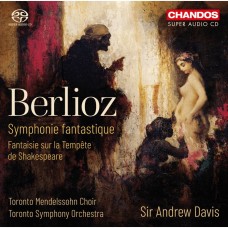|
莎士比亞暴風雨幻想曲
幻想交響曲, 做品14
安德魯.戴維斯 指揮
多倫多交響樂團
多倫多孟德爾頌合唱團
原本是要當作音樂會的序曲並配上合唱的(莎士比亞暴風雨幻想曲)是白遼士在經過四次嘗試才以清唱劇(薩達拿帕勒王 Sardanapale)贏得令人羨慕的羅馬大獎(Prix de Rome)之後譜寫的. 在這專輯中四個樂章的幻想曲, 在經過多種素材的重新加工後, 成為白遼士(雷利奧)獨角戲的結尾(該戲用現有的素材以並列對比方式連結演員吟誦戲劇性的獨白).
(幻想交響曲)是白遼士最有名的作品, 至今仍是管絃樂曲目中的長青樹並且受到全世界聽眾的喜愛. 其以音樂慣例的配器方式來自於白遼士在法國省立銅管樂團的音樂訓練. 這五個樂章的傑作到現在仍然是最傳神的主題交響曲之一(programmatic symphonies), 其革命創新的做法不同於當年優勢的音樂形式常規, 在其中處處可見.
這片錄音作品是在2018年9月的兩場演奏後在加拿大多倫多市的洛伊湯姆笙音樂廳(Roy Thomson Hall)以環繞音效錄製.
Toronto Mendelssohn Choir
Toronto Symphony Orchestra
Sir Andrew Davis
The Fantaisie sur la Tempete de Shakespeare was composed shortly after Berlioz had won the coveted Prix de Rome (at the fourth attempt) with his cantata Sardanapale, and was originally conceived as a concert overture, with chorus. After various re-workings of the material, the four-movement Fantaisie, as recorded here, became the finale of Berlioz’s ‘monodrama’ Lélio – a juxtaposition of existing material interlinked with dramatic monologues recited by the ‘artist’ at the centre of the work.
Symphonie fantastique, Berlioz’s best-known work by some distance, remains an evergreen in the orchestral repertoire, and beloved of audiences the world over. The idiomatic approach to orchestration, grounded in Berlioz’s musical training in French provincial wind-bands, and the revolutionary approach to the prevailing conventions of musical form at the time shine through in the five-movement masterpiece, which remains one of the most vividly programmatic symphonies ever written.
This recording was made after a pair of performances in September 2018 in the Roy Thomson Hall in Toronto, and is made in Surround Sound.
HECTOR BERLIOZ
Fantaisie sur la Tempete de Shakespeare (1830-31) * 14:25
1. Prologue. Andante non troppo lento - [ ] - 3:07
2. La Tempete. Allegro assai, ma primo poco ritenuto - 2:29
3. L'Action. Un poco meno mosso - Meno mosso - 6:51
4. Le Dénoument. Tempo I. Piu animato con fuoco - Presto 1:57
Symphonie fantastique, Op.14 (1830) 55:33
5. I Reveries (Dreams). Largo -15:30
6. II Un bal (A Ball). Valse. Allegro non troppo 6:27
7. III Scène aux champs (Scene in the Country). Adagio 16:00
8. IV Marche au supplice (March to the Scaffold). Allegretto non troppo 6:44
9. V Songe d'une nuit du Sabbat (Dream of a Witches' Sabbath).10:28
Total time: 70:08 |
|



